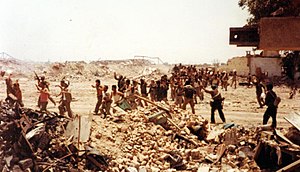Kuye War
| Kuye War | |||||||
|---|---|---|---|---|---|---|---|
 Emmirian forces managing captured Skith Army prisoners following Kuye's return to Emmirian control, 1983 | |||||||
| |||||||
| Belligerents | |||||||
| Skith | |||||||
| Commanders and leaders | |||||||
| Abu Hasan Bani | Esdres Mascarell | ||||||
| Strength | |||||||
| 600,000 | 350,000 soldiers | ||||||
| Casualties and losses | |||||||
| 3,374 killed | 9,000+ killed | ||||||
| 6,800 civilians killed | |||||||
The Kuye War, also known as the Emmiria-Skith War was a war over the Kuye territory of Emmiria and Skith, with the two nations fighting for two months. In 1983, after years of perceived aggression from Skith, Emmiria invaded and annexed the Kuye region, kickstarting the conflict. The war raged for 2 months until international condemnation and major tariff and trade sanctions by the Coalition of Crown Albatross and many governments ceased hostilities on both sides, with the nations of Villorvi and Khaytan becoming independent following the withdrawal.
In the aftermath of the war, Skith fell into economic depression. The adverse occurred in Emmiria, when in 1991 its government fell back into good favor with the international community, co-helming a coalition peacekeeping task force with Durnstaal during the Jiddiyan Civil War. Additionally, trade relations with Alcarres, Sulifa, and Zamastan established Emmiria once again as an economic powerhouse. Skith's government reorganized dramatically following the war, becoming a representative federation and adopting a more friendly international policy. In 2005, it joined WEDA, and Emmiria followed suit 6 years later, officially mending relations between the two countries when President Abolhassan Neeshaan met Prime Minister Temmeni Olarro in Kuye.
